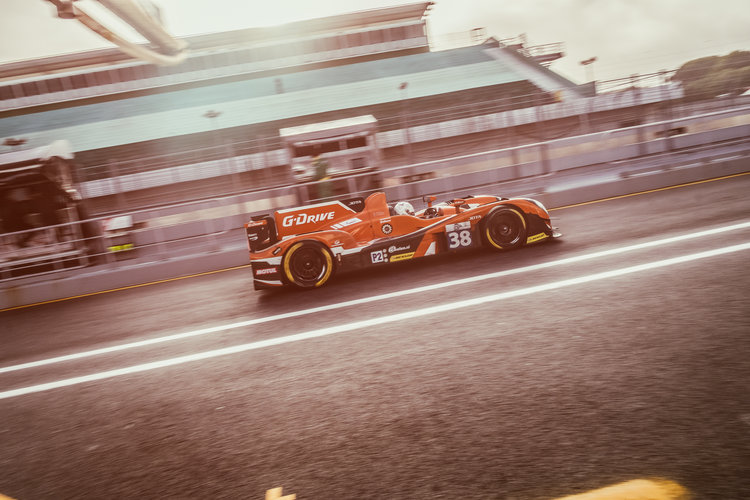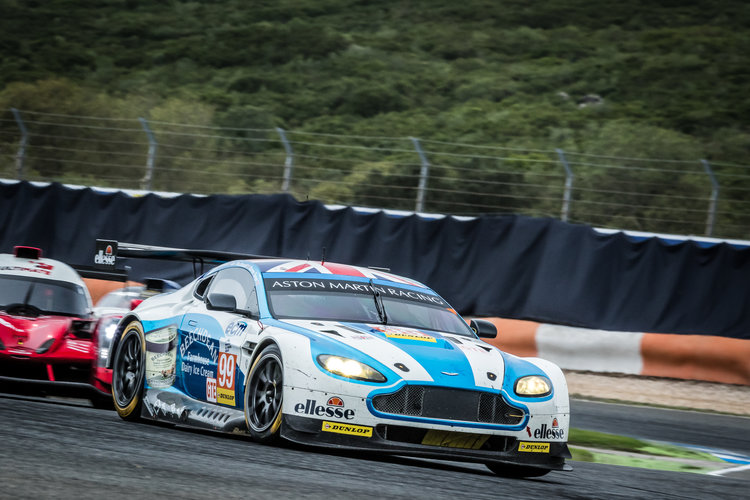After falling agonisingly short the previous two seasons, Jota Sport finally added the European Le Mans Series title to its list of triumphs.
It was a relief as much of a triumph for Simon Dolan’s team, with a tinge of irony added considering this was probably its slimmest chance of claiming the championship to date. In both 2014 and 2015, Jota Sport had entered the final race of the season with one hand on the prize. Both times that advantage slipped away.
The 2014 season saw Jota finish four points adrift of winners Signatech Alpine, while last season it squandered a near-perfect season with a win demotion at Paul Ricard followed by a troublesome run to fourth at Estoril. That double build-up of ecstasy emanated by disappointment made this year’s turnaround – effectuated at the Estoril season finale using an ageing Gibson car – all the more emphatic. Here’s how Jota Sport (this year running as G-Drive Racing) managed to pull it off.
Story of the Season
Race winners:
4 Hours of Silverstone: G-Drive Racing (Dolan/Tincknell/Van der Garde)
4 Hours of Imola: Thiriet by TDS Racing (Ryo Hirakawa/Mathias Beche/Pierre Thiriet)
4 Hours of Red Bull Ring: Thiriet by TDS Racing (Hirakawa/Beche/Thiriet)
4 Hours of Le Castellet: Thiriet by TDS Racing (Beche/Thiriet/Mike Conway)
4 Hours of Spa: DragonSpeed (Nicolas Lapierre/Ben Hanley/Henrik Hedman)
4 Hours of Estoril: G-Drive Racing (Dolan/Tincknell/Van der Garde)

G-Drive Racing, which lent its name to the Jota operation in 2016, overcame Thiriet to win title (Credit: Adrenal Media)
The year started brightly for G-Drive, with a victory on home soil at Silverstone. An early retirement for the rival Thiriet by TDS Racing outfit (another perennial title near-misser) added to the gains, with SMP Racing instead finishing second with its BR01-Nissan. In fact, Silverstone was one of the worst races on record for the French-built ORECAs, with all three of the 05-Nissans entered by Thiriet, DragonSpeed and Eurasia Motorsport failing to finish the race. For G-Drive, it was a handy result considering the ORECAs had been vastly quicker than the Gibson during practice.
That slide in form for the ORECA entries was bucked at Imola during round two, however, when Thiriet by TDS Racing dominated to get its 2016 season up and running. Further victories at the Red Bull Ring and Le Castellet propelled the French team to a position of superficial supremacy. Yet, once again, Thiriet squandered its golden chance to back up the European title it won four years ago.
It had the best driver lineup of 2016, and the quickest chassis in the ORECA 05. The return of Mathias Beche to the team following a spell with Rebellion Racing in LMP1 was a notable scoop, with the Swiss driver exhibiting a world-beating single lap pace. Japanese protege Ryo Hirakawa, whose Super GT commitments meant he couldn’t complete the whole season, also showed flashes of brilliance and will undoubtedly be on the books of a number of teams for next year. When Hirakawa was away, Thiriet benefited from the services of active LMP1 driver Mike Conway, who was part of the lineup that won at Le Castellet. Adding to that the pace of super-silver Pierre Thiriet, this was a team that should have translated its race dominance into a comfortable championship.
However, the team’s Estoril horror show caused by mechanical gremlins paved the way for G-Drive to finally complete the task it had been meaning to carry out the previous two years.

Thiriet missed its big opportunity (Credit: Adrenal Media)
Arguably the stand-out team of 2016 was DragonSpeed. The American outfit, sporting close ties to ORECA with its base set to move to the home of the French manufacturer next season, lost points ground early on with retirements at Silverstone and the Red Bull Ring. Otherwise, it probably would have been in contention for top honours at the end of the campaign.
A major part of the team’s success was Nicolas Lapierre, who staked a claim to being one of the quickest prototype drivers in the world this year with his ELMS performances. The Toyota LMP1 expat often frequented the top of the timesheets during practice, and on race day would readily make the majority of his professional counterparts look decidedly average. As one of the ‘true’ pro-am LMP2 lineups, DragonSpeed often found itself losing ground after a rapid start from Lapierre, although silver driver Henrik Hedman showed chunks of composure, notably at Spa where the team scooped its only win of the season. Ben Hanley was also a notable performer in the red, white and blue ORECA 05, establishing himself as an LMP2 danger-man with excellent drives at Spa and Estoril.
Also worthy of note was the campaign had by Russian outfit SMP Racing, running its curious Nissan-powered BR01 chassis. The SMP squad had a successful, if a little unfulfilling, year, with its #32 car entering the final race with an outside shot of the championship. Unfortunately for Andreas Wirth, Julian Leal and Stefano Coletti that goal was put out of reach by the dominance of G-Drive Racing in Portugal, but the fact that the trio stayed in the game so far tells a lot. Second place finishes at Silverstone and Le Castellet were highlights, although the lack of a victory for the BR01 meant champion status would always be difficult to clinch.

DragonSpeed raised more than a few eyebrows with its late-season run (Credit: Adrenal Media)
LMP3 – United Divides the Field
A step up from flirting around a dozen to 20 regular entries marked the ‘proper’ introduction of LMP3 to the European Le Mans Series.
Whereas last season was about testing the waters with the new junior prototype category, 2016 offered a glimpse of its full potential.
Fantastic racing was to be head throughout the pro-am field, but come the season-opening 4 Hours of Silverstone in April a number of sharp-end mainstayers had made themselves known.
United Autosports led that charge, with one its Ligier JSP3s going on to win the championship comprehensively.
Alex Brundle, Christian England and Mike Guasch were irrepressible for most of the year, winning the first three races before claiming podiums at Le Castellet and Spa.
The key to United’s success was in its reading of the class rulebook surrounding pit strategy. In LMP3, the cars are limited to a minimum time they can spend during a pit stop. Usually three pit stops are carried out during a race by each team, with every service facilitating a driver change. One of those three stops can be shorter than the others: in the ELMS this year most teams opted to get this out of the way early to gain a track position advantage.

Richard Dean’s United Autosports squad commandeered LMP3 (Credit: United Autosports)
The converse strategy was employed by United Autosports, with its two cars serving the short stop at the tail end of the race to surge through into the lead after seemingly falling into obscurity at the end of each opening stint. That, coupled with the pace of the driver trio – especially the gold-rated Brundle – meant United had the title wrapped up one round prior to the Estoril closer.
Having the trophy in hand meant Guasch’s heavy crash in Portugal didn’t quite carry the level of significance it might have done, but as we’ll find out below the incident signalled dramatic implications for the LMGTE championship.
The two races United didn’t win were paced by the second-best LMP3 entry of 2016, run by French outfit Graff Racing.
After making a toe-in-the-water cameo at Estoril in 2015, Graff arrived at the start of this season expecting to pick up some silverware with its two Ligier JSP3s adorned in the national colours. Its driver trio of Paul Petit, Enzo Guibbert and Eric Trouillet demonstrated that they were more than capable of putting up the fight to United, claiming two comprehensive victories at Paul Ricard and Spa. Third in the championship went to the Duqueine Engineering duo of David Hallyday and Dino Lunardi, with the sister United Autosports entry of Mark Patterson, Wayne Boyd and Matt Bell falling to fourth after encountering problems in Austria and France.
In sum, LMP3 experienced a surge of interest in 2016. That interest will be monitored closely by the organisers next season, with LMP3 cars soon to be admitted to the Michelin Le Mans Cup as a means of reducing the density of the ELMS field. More variety is also expected, and required, to maintain the health of this exciting junior formula. Ligier has sold in excess of 100 JSP3 chassis now, with its chief rivals at ADESS, Riley/Ave and Ginetta on considerably fewer entries. Still, the class has shown plenty of promise this season, and even if the other manufacturers are unable to challenge Ligier’s monopoly there is no doubt that its popularity will continue moving forward.

LMP3 helped elevate grid numbers in excess of 40 (Credit: Adrenal Media)
LMGTE – Final-race Heartbreak for JMW
When even the silver lining of a guaranteed Le Mans entry can’t be useful as a consolation, something must have gone very wrong.
JMW Motorsport secured its place at the 24 hour classic with three successive victories at the Red Bull Ring, Le Castellet and Spa, only for a nightmarish final weekend at Estoril to undo the British team’s nailed on chances of a maiden European title.
Requiring a seventh place finish in an eight-car field, Rory Butcher, Rob Smith and Andrea Bertolini knew that a consistent and unspectacular run to the flag would see them through.
Sadly for JMW, the type of race that transpired was not the kind lending itself to such a performance. Crashes and incidents, most of them involving LMP3 cars, hallmarked a chaotic encounter which came after a topsy-turvy wet qualifying session on Saturday.
After sustaining a gearbox problem early on, the team put its yellow and red Ferrari 458 Italia into damage limitation mode for the remainder of the contest, until Smith was taken out by the spinning United Autosports LMP3 car of Mike Guasch.
Guasch caught too much curb on the exit of the corner, pitching his Ligier into a clockwise rotation that was blunted by the side panel of Smith’s hapless Ferrari. Extraordinarily, Smith managed to bring his car back into the pits, but the team was forced to retire with time running out.
That handed the championship to Aston Martin Racing, with Andrew Howard’s Beechdean outfit claiming a European title at the first attempt. It would be easy to say that AMR got lucky on this occasion, but the consistent performances of Howard, Darren Turner and Alex MacDowall were not to be sniffed at.
Granted, their only victory of the season came at Silverstone where they were the benefactors of a post-race penalty for JMW, which, had it not been for a minor technical infringement, would have led to the championship going the other way. However, the team’s solidity throughout the season – marked by a 100% top five finish rate and no retirements – meant their place at the top was vindicated.

Beechdean AMR snatched the title away from JMW (Credit: Adrenal Media)
Postscript
The European Le Mans Series maintained its reputation as one of the world’s most competitive sportscar arenas with another thrilling title chase in 2016. Combining with the Renault Sport support package, the ELMS is continuing to strengthen its grip as a prestigious championship in its own right, whilst keeping true as a feeder series to the World Endurance Championship.
Next season will no doubt be about consolidation, but the ACO organising body is always seeking ways of improving its regional product. The hallowed tarmac at Monza replaces Imola as the Italian round next season, while Portimao comes in as a replacement for the Estoril closer.



